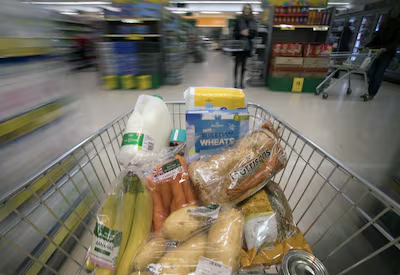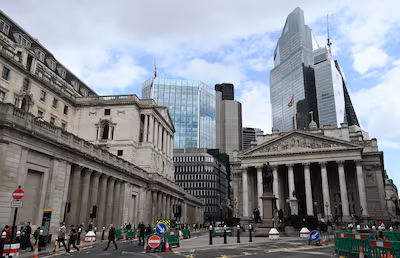Inflation in the UK fell to 10.1 per cent in March, from 10.4 per cent the month before, the Office for National Statistics has said.
Stubbornly high prices continue to weigh on British consumers, especially in the food sector.
Inflation had been expected to fall into the single digits, following the surprise jump in the figures in February.
Economists polled by Reuters had forecast that the annual Consumer Price Index rate would drop to 9.8 per cent in March. UK inflation hit a 41-year high of 11.1 per cent last October.
Reacting to the inflation numbers, UK Chancellor Jeremy Hunt said: "These figures reaffirm exactly why we must continue with our efforts to drive down inflation so we can ease pressure on families and businesses.
"We are on track to do this — with the OBR (Office for Budget Responsibility) forecasting we will halve inflation this year — and we'll continue supporting people with cost-of-living support worth an average of £3,300 per household over this year and last, funded through windfall taxes on energy profits."
Despite the dip in inflation in March, the UK still has the highest inflation in western Europe.
"Inflation should continue to fall over the rest of this year, thanks to lower energy prices and base effects unwinding," said Alpesh Paleja, Lead Economist at the Confederation of British Industry (CBI).
"But with the CPI rate set to stay above the Bank of England’s target, this will still be a tough year for many households – in particular, the strength in food price inflation will continue to have a big impact on peoples’ pockets."

Food prices still soaring
Food prices rose 19.1 per cent in the year to March, the sharpest jump since August 1977, according to the ONS.
The prices of bread, cereals and fruit all increased and the recent shortage of some vegetables in the UK was still being carried through to the inflation numbers.
According to the ONS, the average price of olive oil has risen 49.2 per cent in the year to March. Likewise, sugar is up 42.1 per cent, cheese is 33.6 per cent higher and pasta and couscous are 24.1 per cent higher.
Much of the downwards pressure on inflation came from fuel, with motor fuel prices falling by 5.9 per cent in the year to March, compared with a rise of 4.6 per cent in February, the ONS said.
The inflation figures show that disposable incomes in British households remain "under the cosh," according to Alice Haine, Personal Finance Analyst at Bestinvest.
"When you consider the additional challenges posed by higher mortgage costs, falling real incomes, higher taxes and the prospect that the Bank of England could still hike interest rates for the 12th time in a row next month, households should not start splashing the cash just yet," she added.
"People still need to spend wisely by living within their means, avoiding expensive debt and saving and investing to shore up their financial futures."

Core inflation is 'sticky'
While inflation looks set to fall for the rest of the year, the Bank of England now needs to judge how fast and how far prices will drop when deciding on moves in interest rates.
The problem for the Bank of England is that while inflation now seems to be back on a declining track, following the surprise jump in February, wage growth figures released on Tuesday were stronger than expected.
However, the ONS also released producer input price data on Wednesday which showed a 7.6 per cent rise in the year to March, down from 12.8 per cent in the previous month.
Predicting a further rise in interest rates, Kitty Ussher, Chief Economist at the Institute of Directors, believes that core inflation in the UK remains "sticky" and the Bank of England's job is "not done yet".
“Taken together with yesterday’s strong labour market data it is now clear that there is more demand in the economy than the Bank of England had expected in Q1," she said.
“The headline rate will come down a notch in April as base effects from last year work their way through the data, but to address the underlying issues the MPC still needs to raise rates again when it meets in a few weeks’ time.”
Meanwhile, the markets have factored in an 80 per cent chance that the Bank of England will raise interest rates at their next meeting.
The prospect of a rate raise by the Bank of England sooner rather than later, helped the British pound move higher in morning trade of Wednesday.
The currency jumped about 0.49 per cent shortly after the inflation figures were released to 1.2470 against the US dollar, but later fell back to trade at 1.2424 by late morning.
“The market had increasingly speculated on the Bank of England pausing their campaign of interest rate hikes at their next meeting, but this less-than-anticipated decline may put a stop to those predictions," said Srijan Katyal, global head of strategy and trading services at the international brokers ADSS.
Britain’s rate of inflation continues to be much more stubborn than in the US and Europe, where the CPI has been falling at a faster rate for months. In the US, prices rose 5 per cent last month, the slowest in almost two years, while in the eurozone inflation was 6.9 per cent, the lowest since last February.





